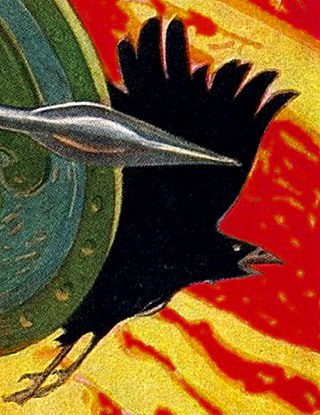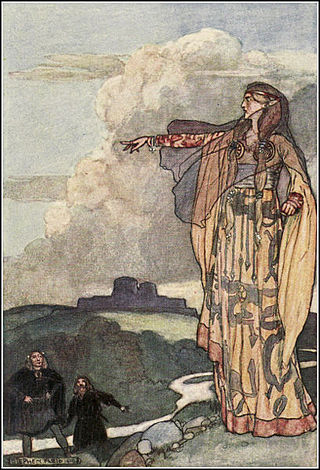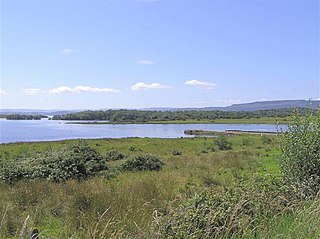
Irish mythology is the body of myths indigenous to the island of Ireland. It was originally passed down orally in the prehistoric era. In the early medieval era, some myths were transcribed by Christian monks, who heavily altered and Christianised the myths. Irish mythology is the best-preserved branch of Celtic mythology.

Lugh or Lug is a figure in Irish mythology. A member of the Tuatha Dé Danann, a group of supernatural beings, Lugh is portrayed as a warrior, a king, a master craftsman and a saviour. He is associated with skill and mastery in multiple disciplines, including the arts. Lugh also has associations with oaths, truth and the law, and therefore with rightful kingship. Lugh is linked with the harvest festival of Lughnasadh, which bears his name. His most common epithets are Lámfada and Samildánach. This has sometimes been anglicised as "Lew of the Long Hand".

The Morrígan or Mórrígan, also known as Morrígu, is a figure from Irish mythology. The name is Mór-ríoghan in modern Irish before the spelling reform, and it has been translated as "great queen" or "phantom queen".

The TuathaDé Danann, also known by the earlier name Tuath Dé, are a supernatural race in Irish mythology. Many of them are thought to represent deities of pre-Christian Gaelic Ireland.
Conn Cétchathach, or Conn of the Hundred Battles, son of Fedlimid Rechtmar, was a legendary High King of Ireland who is claimed to be the ancestor of the Connachta, and through his descendant Niall Noígiallach, the Uí Néill dynasties, which dominated Ireland in the early Middle Ages.

In Irish mythology, Nuada or Nuadu, known by the epithet Airgetlám, was the first king of the Tuatha Dé Danann. He is also called Nechtan, Nuadu Necht and Elcmar, and is the husband of Boann. He is mostly known from the tale in which he loses his arm or hand in battle, and thus his kingship, but regains it after being magically healed by Dian Cécht. Nuada is thought to have been a god and is related to the British and Gaulish god Nodens, who is associated with hunting and fishing. His Welsh equivalent is Nudd or Lludd Llaw Eraint.
In Irish mythology, Goibniu was the metalsmith of the Tuatha Dé Danann. He is believed to have been a smithing god and is also associated with hospitality. His name is related to the Welsh Gofannon and the Gaulish Gobannus.

Macha was a sovereignty goddess of ancient Ireland associated with the province of Ulster, particularly the sites of Navan Fort and Armagh, which are named after her. Several figures called Macha appear in Irish mythology and folklore, all believed to derive from the same goddess. She is said to be one of three sisters known as 'the three Morrígna'. Like other sovereignty goddesses, Macha is associated with the land, fertility, kingship, war and horses.

Nemed or Nimeth is a character in medieval Irish legend. According to the Lebor Gabála Érenn, he was the leader of the third group of people to settle in Ireland: the Muintir Nemid, Clann Nemid or "Nemedians". They arrived thirty years after the Muintir Partholóin, their predecessors, had died out. Nemed eventually dies of plague and his people are oppressed by the Fomorians. They rise up against the Fomorians, attacking their tower out at sea, but most are killed and the survivors leave Ireland. Their descendants become the Fir Bolg.
In Irish mythology, Dian Cécht was the god of healing, the healer for the Tuatha Dé Danann, and son of the Dagda according to the Dindsenchas.
Ogma is a god from Irish and Scottish mythology. A member of the Tuatha Dé Danann, he is often considered a deity and may be related to the Gallic god Ogmios. According to the Ogam Tract, he is the inventor of Ogham, the script in which Irish Gaelic was first written.
In Irish mythology, Neman or Nemain is the spirit-woman or goddess who personifies the frenzied havoc of war. In the ancient texts where The Morrígan appears as a trio of goddesses — the three sisters who make up the Morrígna — include Macha and Badb; Nemain is strongly associated with Badb with whom she shares a husband, Neit. Nemain may be an aspect of Badb.
Cathair Mór, son of Feidhlimidh Fiorurghlas, a descendant of Conchobar Abradruad, was, according to Lebor Gabála Érenn, a High King of Ireland. He took power after the death of Fedlimid Rechtmar. Cathair ruled for three years, at the end of which he was killed by the Luaigne of Tara, led by Conn Cétchathach. The Lebor Gabála Érenn synchronises his reign with that of the Roman emperor Marcus Aurelius (161–180). The chronology of Geoffrey Keating's Foras Feasa ar Éirinn dates his reign to 113–116, that of the Annals of the Four Masters to 119–122.

In Irish mythology, Ethniu in modern spelling, is the daughter of the Fomorian leader Balor, and the mother of Lugh. She is also referred to as Ethliu.
In the Mythological Cycle of early Irish literature, the four treasures of the Tuatha Dé Danann are four magical items which the mythological Tuatha Dé Danann are supposed to have brought with them from the four island cities Murias, Falias, Gorias, and Findias when they arrived in Ireland.

Cath Maige Tuired is the name of two saga texts of the Mythological Cycle of Irish mythology. It refers to two separate battles in Connacht: the first in the territory of Conmhaícne Cúile Tuireadh near Cong, County Mayo, the second near Lough Arrow in County Sligo. The two texts tell of battles fought by the Tuatha Dé Danann, the first against the Fir Bolg, and the second against the Fomorians.

The Mythological Cycle is a conventional grouping within Irish mythology. It consists of tales and poems about the god-like Tuatha Dé Danann, who are based on Ireland's pagan deities, and other mythical races such as the Fomorians and Fir Bolg. It is one of the four main story 'cycles' of early Irish myth and legend, along with the Ulster Cycle, the Fianna Cycle and the Cycles of the Kings. The name "Mythological Cycle" seems to have gained currency with Arbois de Jubainville c. 1881–1883. James MacKillop says the term is now "somewhat awkward", and John T. Koch notes it is "potentially misleading, in that the narratives in question represent only a small part of extant Irish mythology". He prefers T Ó Cathasaigh's name, Cycle of the Gods. Important works in the cycle are the Lebor Gabála Érenn, the Cath Maige Tuired, the Aided Chlainne Lir and Tochmarc Étaíne.
In Irish mythology Neit was a god of war. He was the husband of Nemain and/or Fea, and sometimes of Badb. Also grandfather of Balor, he was killed at the legendary Second Battle of Moytura.
Ernmas is an Irish mother goddess, mentioned in Lebor Gabála Érenn and "Cath Maige Tuired" as one of the Tuatha Dé Danann. Her daughters include the trinity of eponymous Irish goddesses Ériu, Banba and Fódla, the trinity of war goddesses the Badb, Macha and Mórrígan, and also a trinity of sons, Glonn, Gnim, and Coscar. Her other sons are Fiacha and Ollom. Ernmas was killed during the first battle of Mag Tuired and is called a "she-farmer" in the Lebor Gabála Érenn.

Boa Island is an island near the north shore of Lower Lough Erne in County Fermanagh, Northern Ireland. It is 16 mi (26 km) from Enniskillen town.










